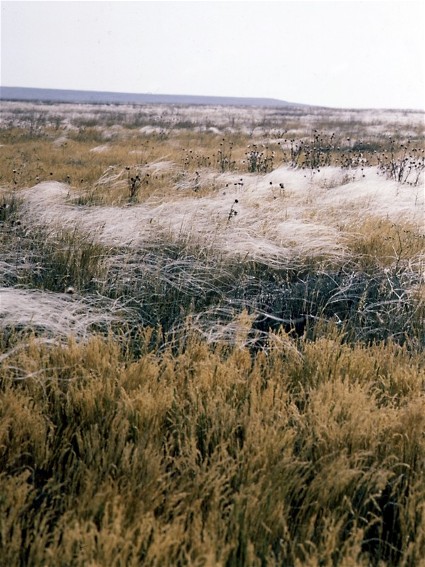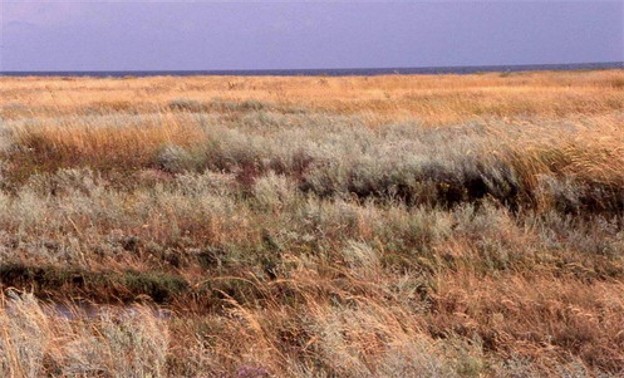Black Sea Lowland
Black Sea Lowland. (Map: Black Sea Lowland.) A great low plain in southern Ukraine, extending from the chain of uplands in the north (Bessarabia, Podilia, Dnipro Upland, and Zaporozhian Ridge) and the northeast (Azov Upland and Donets Ridge) to the Black Sea and the Sea of Azov in the south; from the Danube River in the west to the Lower-Don Lowland in the east. The northern boundary of the Black Sea Lowland is not definite: it is defined by the line of the extreme outcroppings of the layers of the Ukrainian Crystalline Shield. The Crimean Lowland is a part of the Black Sea Lowland. The width of the Black Sea Lowland varies from 50 km in the west and the east to 180 km in the middle. The eastern part of the lowland—the Azov Lowland—narrows down to 10–20 km. The Black Sea Lowland lies wholly within the boundaries of the historical-geographical region known as southern Ukraine and comprises almost a half of its territory.
By its tectonic structure the Black Sea Lowland is a part of the Black Sea Depression, which consists of thick, almost horizontal layers of sediment, mostly Paleocene and Neocene sea deposits (various clays, sands, limestones, sandy clays, and sandy limestones) overlaid with continental deposits of the Anthropogene period (reddish-brown clays, loess usually over 20 m deep, and loessial loams). Tertiary deposits are exposed only in river valleys and in some places on the sea coast. The Black Sea Lowland was covered by the Pontic Sea as recently as the Lower Pliocene. Eventually it became dry land, dissected by a few small rivers. This process was cut short by the uplifting of the sea, which flooded the river mouths and caused estuaries to form.
Now the Black Sea Lowland is an accumulative, weakly divided plain, which gradually slopes towards the Black Sea and the Sea of Azov (from 160 m in the north to 10–15 m in the south) and usually meets the seas by a steep drop. The lowland is dissected by a fairly thin network of river valleys of the Dnister River, Boh River, Inhul River, Inhulets River, Dnipro River, Molochna River, and lesser rivers. The depth of the valleys varies from 80 m in the north to 20–25 m in the south. The river valleys are broad and distinct, with three to five accumulative terraces. Landslips have developed on the steep right slopes of the valleys. The mouths of the rivers that enter the sea widen out and form limans. Broad swampy terraces or floodplains are characteristic of the valleys of the larger rivers, such as the Dnipro River, Danube River, and Dnister River.
The valley slopes are cut by many gullies and ravines. The gullies have a southerly direction and cut into the intervalley plains. The most dissected surface is the western part of the lowland, between the Danube and the Boh; somewhat less dissected is the middle part between the Boh River and the Dnipro River; and the least dissected is the part between the Dnipro River and the Molochna River. The extensive intervalley plains are infrequently and weakly complicated by shallow, closed depressions called pody, which fill with meltwaters in the spring, and by smaller, saucerlike steppe hollows. These two formations are prevalent in the eastern part of the lowland and are also found in the central part. Numerous burial mounds rise up to 10 m above the flat steppe.
A unique landscape is presented by the alluvial plain on the left bank of the lower Dnipro River called Oleshia Sands (a waterless, sandy plain that was once the Dnipro-Boh Estuary), and by the area on both sides of Syvash Lake, which was formed as the sea advanced on the dryland. The most variegated landscape is found on the sea coast, and it results from the interaction of various forces on the sea-land borderline.
BIBLIOGRAPHY
Bondarchuk, V. Heomorfolohiia URSR (Kyiv 1949)
—Heolohichna budova Ukraïns'koï RSR (Kyiv 1963)
Lan'ko, A.; Marynych, O.; Shcherban', M. Fizychna heohrafiia Ukraïns'koï RSR (Kyiv 1969)
Volodymyr Kubijovyč
[This article originally appeared in the Encyclopedia of Ukraine, vol. 1 (1984).]


.jpg)